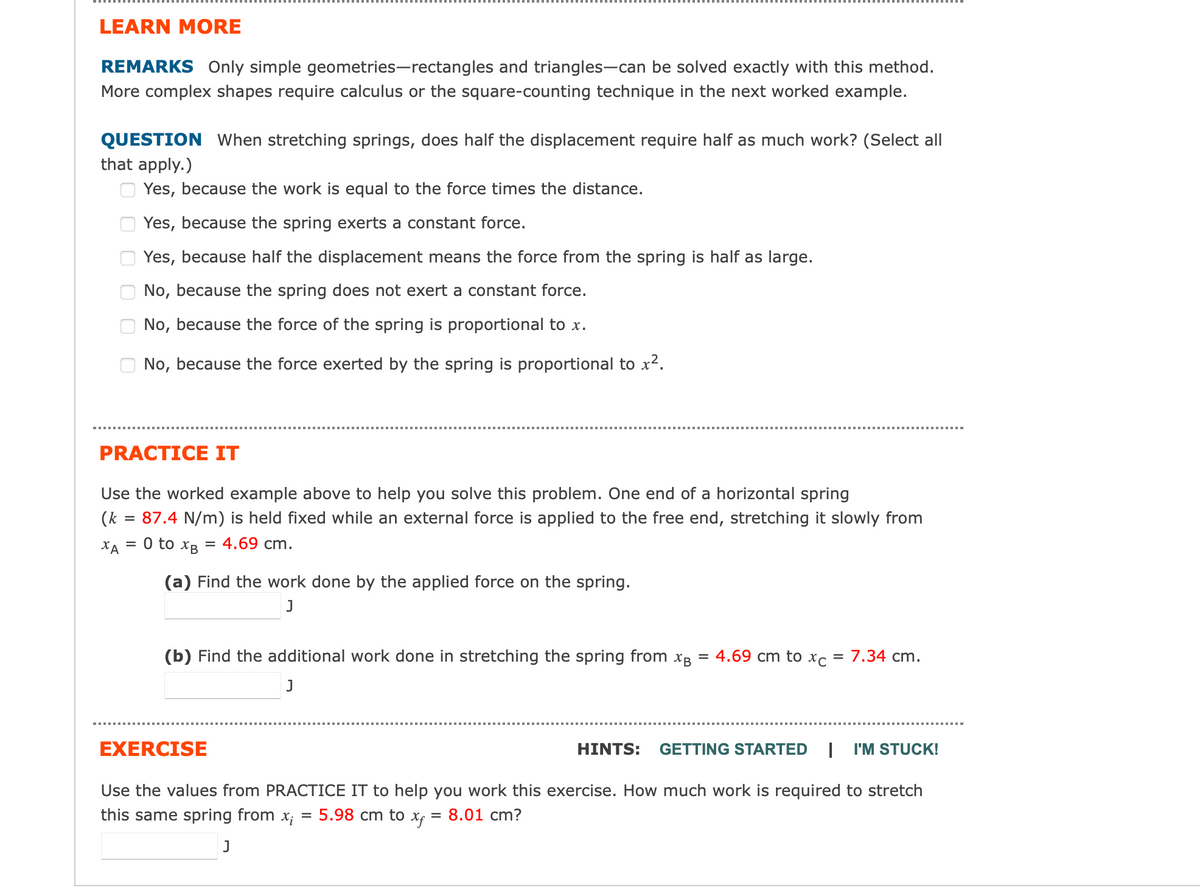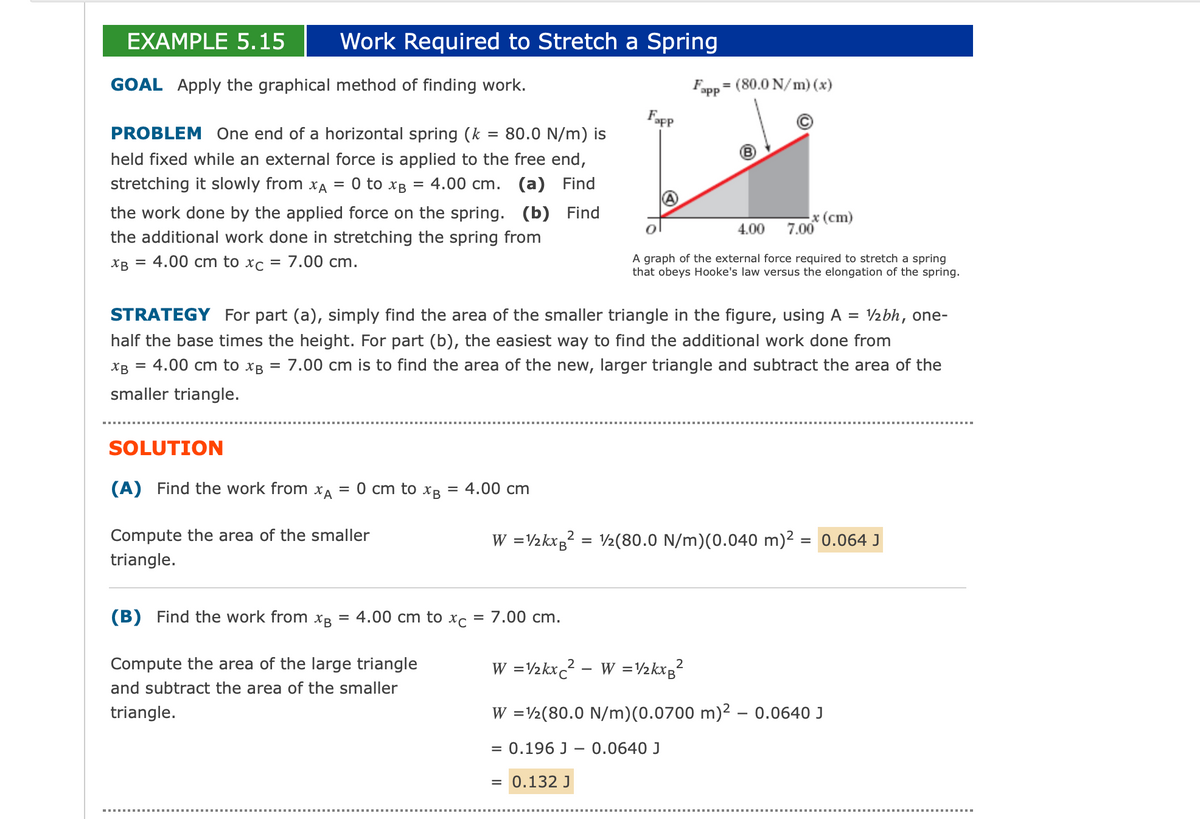LEARN MORE REMARKS Only simple geometries-rectangles and triangles-can be solved exactly with this method. More complex shapes require calculus or the square-counting technique in the next worked example. QUESTION When stretching springs, does half the displacement require half as much work? (Select all that apply.) Yes, because the work is equal to the force times the distance. Yes, because the spring exerts a constant force. Yes, because half the displacement means the force from the spring is half as large. No, because the spring does not exert a constant force. No, because the force of the spring is proportional to x. No, because the force exerted by the spring is proportional to x². PRACTICE IT Use the worked example above to help you solve this problem. One end of a horizontal spring (k = 87.4 N/m) is held fixed while an external force is applied to the free end, stretching it slowly from XA = 0 to xB = 4.69 cm. (a) Find the work done by the applied force on the spring. J (b) Find the additional work done in stretching the spring from xg = 4.69 cm to xc = 7.34 cm. J EXERCISE Use the values from PRACTICE IT to help you work this exercise. How much work is required to stretch this same spring from x; = 5.98 cm to xf = 8.01 cm? J HINTS: GETTING STARTED I I'M STUCK!
LEARN MORE REMARKS Only simple geometries-rectangles and triangles-can be solved exactly with this method. More complex shapes require calculus or the square-counting technique in the next worked example. QUESTION When stretching springs, does half the displacement require half as much work? (Select all that apply.) Yes, because the work is equal to the force times the distance. Yes, because the spring exerts a constant force. Yes, because half the displacement means the force from the spring is half as large. No, because the spring does not exert a constant force. No, because the force of the spring is proportional to x. No, because the force exerted by the spring is proportional to x². PRACTICE IT Use the worked example above to help you solve this problem. One end of a horizontal spring (k = 87.4 N/m) is held fixed while an external force is applied to the free end, stretching it slowly from XA = 0 to xB = 4.69 cm. (a) Find the work done by the applied force on the spring. J (b) Find the additional work done in stretching the spring from xg = 4.69 cm to xc = 7.34 cm. J EXERCISE Use the values from PRACTICE IT to help you work this exercise. How much work is required to stretch this same spring from x; = 5.98 cm to xf = 8.01 cm? J HINTS: GETTING STARTED I I'M STUCK!
Related questions
Question

Transcribed Image Text:LEARN MORE
REMARKS Only simple geometries-rectangles and triangles-can be solved exactly with this method.
More complex shapes require calculus or the square-counting technique in the next worked example.
QUESTION When stretching springs, does half the displacement require half as much work? (Select all
that apply.)
Yes, because the work is equal to the force times the distance.
Yes, because the spring exerts a constant force.
Yes, because half the displacement means the force from the spring is half as large.
No, because the spring does not exert a constant force.
No, because the force of the spring is proportional to x.
No, because the force exerted by the spring is proportional to x².
PRACTICE IT
Use the worked example above to help you solve this problem. One end of a horizontal spring
(k = 87.4 N/m) is held fixed while an external force is applied to the free end, stretching it slowly from
XA = 0 to xB = 4.69 cm.
(a) Find the work done by the applied force on the spring.
J
(b) Find the additional work done in stretching the spring from B
J
4.69 cm to xc = 7.34 cm.
EXERCISE
HINTS: GETTING STARTED I I'M STUCK!
Use the values from PRACTICE IT to help you work this exercise. How much work is required to stretch
this same spring from x; = 5.98 cm to xf = 8.01 cm?
J

Transcribed Image Text:EXAMPLE 5.15 Work Required to Stretch a Spring
GOAL Apply the graphical method of finding work.
PROBLEM One end of a horizontal spring (k = 80.0 N/m) is
held fixed while an external force is applied to the free end,
stretching it slowly from XA = 0 to xB = 4.00 cm. (a) Find
the work done by the applied force on the spring. (b) Find
the additional work done in stretching the spring from
XB = 4.00 cm to xc = 7.00 cm.
SOLUTION
(A) Find the work from XA = 0 cm to XB
Compute the area of the smaller
triangle.
4.00 cm
(B) Find the work from xg = 4.00 cm to xc
Compute the area of the large triangle
and subtract the area of the smaller
triangle.
Fapp
STRATEGY For part (a), simply find the area of the smaller triangle in the figure, using A = 1/₂bh, one-
half the base times the height. For part (b), the easiest way to find the additional work done from
XB = 4.00 cm to xB 7.00 cm is to find the area of the new, larger triangle and subtract the area of the
smaller triangle.
= 7.00 cm.
F =
app
-
(80.0 N/m) (x)
x (cm)
W = 1/2kxB²
4.00 7.00
A graph of the external force required to stretch a spring
that obeys Hooke's law versus the elongation of the spring.
W = 1/2kxB² = 1/2 (80.0 N/m)(0.040 m)² = 0.064 J
W = 1/2kxc²
W = 1/2 (80.0 N/m)(0.0700 m)2 - 0.0640 J
= 0.196 J- 0.0640 J
= 0.132 J
Expert Solution
This question has been solved!
Explore an expertly crafted, step-by-step solution for a thorough understanding of key concepts.
Step by step
Solved in 2 steps with 2 images
